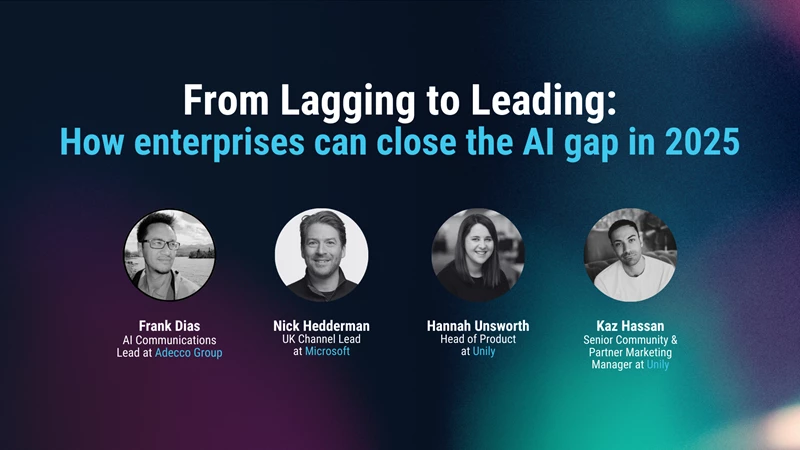Celebrating Global Accessibility Awareness Day: Empowering all users
On this Global Accessibility Awareness Day, we aim to promote understanding and raise awareness about accessibility. We are celebrating GAAD by shedding light on the importance of accessibility, assistive technology and how Unily as a company is committed to providing accessible solutions that go beyond compliance.

Lifting the lid of digital workplace accessibility
It’s estimated that 1 in 5 adults in the workplace are affected by disability. That’s 664m workers. And despite increased focus on diversity, equity and inclusion initiatives, Gartner still finds that “the digital workplace often fails people with disabilities.”
In the new digital-first workplace, we are embracing opportunities to better enable our people and tear down longstanding barriers to engagement. Intranets have been transformed into dynamic employee experience platforms where everyone from an organization can come together to collaborate, share knowledge, and contribute to the culture of an enterprise. But for employees with disabilities, challenges to access still prevail.
We are seeing progress. The number of job listings with accessibility in the title grew 78% from July 2020 to July 2021 according to Forrester. Gartner also predict that by 2025, 80% of organizations will use accessibility as a key criterion for digital workplace tech investments.
But before we can make true progress, we must understand what we really mean by accessibility and what features we have at our fingertips to empower every employee with access to the tools they need to succeed at work.
Understanding disabilities: Opening the doors to inclusivity
Before we explore accessibility, let's first understand disabilities and their impact. Disabilities come in different forms, such as difficulty seeing, hearing, moving, thinking, or understanding. These challenges affect how individuals interact with digital content. By acknowledging and understanding these challenges, we can better design solutions that cater to a wide range of users.
It's essential to understand the diverse range of disabilities that individuals may experience. Disabilities can be categorized into physical, sensory, and cognitive impairments. Let's take a closer look at each category and provide some examples:
#1. Physical Disabilities: These disabilities affect a person's physical functioning and mobility. Examples include:
- Mobility Impairment: Difficulties in walking, using limbs, or maintaining balance.
- Spinal Cord Injury: Paralysis or loss of motor function due to damage to the spinal cord.
- Amputation: The loss of a limb, requiring the use of prosthetics or assistive devices.
#2. Sensory Disabilities: These disabilities impact the senses of sight, hearing, and touch. Examples include:
- Visual Impairment: Partial or total loss of vision, including conditions like blindness or low vision.
- Hearing Impairment: Partial or total loss of hearing, requiring the use of hearing aids or assistive listening devices.
- Deaf blindness: Combined visual and hearing impairments, requiring communication through tactile or sign language.
#3. Cognitive Disabilities: These disabilities affect cognitive processes, such as memory, attention, and problem-solving. Examples include:
- Learning Disabilities: Challenges in reading, writing, or understanding information, such as dyslexia or dysgraphia.
- Attention Deficit Hyperactivity Disorder (ADHD): Difficulty with focus, impulsivity, and hyperactivity.
- Autism Spectrum Disorder (ASD): Differences in social communication, interaction, and behaviour.
What is accessibility?
Accessibility means making digital products, services, and environments usable for a wide range of users including individuals with disabilities. It involves removing barriers that may prevent people from accessing, navigating, and interacting with information or technology. By following and implementing accessibility best practices, we strive to provide everyone with equal opportunities to participate in the digital world.
What is assistive technology?
Assistive technology plays a vital role in enhancing accessibility for individuals with disabilities. These tools and devices are designed to assist individuals in overcoming specific challenges and accessing digital content. Here are a few examples:
#1. Screen Readers: Software that converts on-screen text into synthesized speech, enabling individuals with visual impairments to access written content.
#2. Alternative Input Devices: Specialized keyboards, switches, or eye-tracking systems that allow individuals with motor impairments to interact with computers and devices effectively.
#3. Closed Captioning: Textual representation of audio content, aiding individuals with hearing impairments in understanding spoken information in videos or presentations.
#4. Cognitive Assistance Tools: Software that provides visual cues, reminders, or simplifies complex information; supporting individuals with cognitive disabilities in navigating digital interfaces.
Understanding WCAG and its levels
WCAG (Web Content Accessibility Guidelines) is a global standard for digital accessibility. It provides guidelines and success criteria for creating accessible digital content and technology. The WCAG has three levels of conformance: A, AA, and AAA, representing increasing levels of accessibility compliance. These guidelines cover various aspects, including making content perceivable, interfaces operable, information understandable, and technology robust.
Unily’s commitment to accessibility
Unily is committed to providing accessible solutions that a wide range of users can access and use. We strive to meet the internationally recognized web content accessibility guidelines (WCAG) 2.1 Level AA standards and follow accessibility best practices. External audits are regularly conducted to validate our work; whilst we aim to comply with WCAG, our priority is to ensure that our product is useable and not just compliant.
Our commitment to accessibility has been strengthened by the recent introduction of a digital accessibility manager role. This will provide a greater focus across Unily on accessibility.
"I am passionate about making digital content inclusive. As a blind person, I have personal experience of the challenges of accessing digital content. I have either been unable to access certain products or services, or have had to use lengthy workarounds. This experience, combined with my eleven years of industry experience with companies such as Gartner, Shell and UK Cabinet office, has given me a unique perspective on accessibility. I am glad to be part of Unily, a company that is committed to making its platform accessible to all users. Unily understands the importance of inclusivity and is taking the necessary steps to make its intranet solution accessible out-of-the-box. I am excited to lead this initiative and help provide equal access to digital content for individuals. "
The broader impact of accessibility
Accessibility positively impacts individuals with disabilities and extends its benefits to a broader audience. It enhances user experiences, facilitates inclusion and promotes equal access to digital information and services. By embracing accessibility, we create a digital world where everyone can participate.
Discover the power of Unily On this Global Accessibility Awareness Day, let us recognize the importance of accessibility and push for greater commitment to providing accessible solutions that empower every employee. By understanding disabilities, adopting accessibility best practices, and prioritizing inclusive design, we can empower all users to access and engage with the digital world equally. To find out more about how Unily supports enterprises to create inclusive workplaces with an accessible employee experience platform, get started with a free demo of our market-leading product today.
Discover the power of Unily
On this Global Accessibility Awareness Day, let us recognize the importance of accessibility and push for greater commitment to providing accessible solutions that empower every employee. By understanding disabilities, adopting accessibility best practices, and prioritizing inclusive design, we can empower all users to access and engage with the digital world equally.
To find out more about how Unily supports enterprises to create inclusive workplaces with an accessible employee experience platform, get started with a free demo of our market-leading product today.
Get started. Get your personalized demo.
Reinvent your intranet for the employee experience era.

















